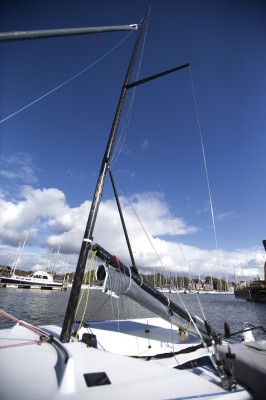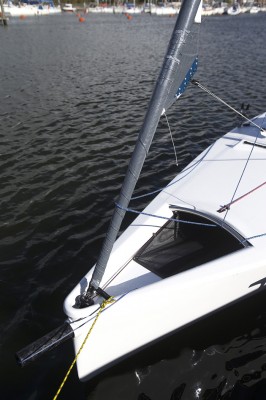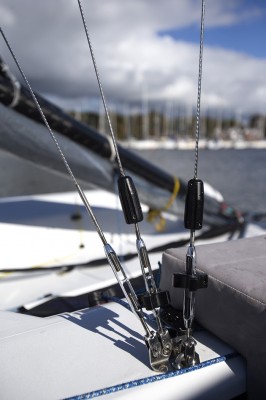So far there has not been a planing keelboat class to touch the Uffa Fox Flying 15. Could the VX One be the one? Matthew Sheahan is impressed
I’ll come straight out with it: there are some boats that hit the spot from the outset and for me the VX One is on that list. In fact, I’ll go further. This two- or three-crew 19ft performance keelboat was my favourite boat of 2014. It is, quite simply, superb.
Bridging the gap between dinghies and keelboats has always been tricky. What’s good for those used to hiking with their well-trained quads, honed stomach muscles and backsides that only feel right if they keep slapping the tops of the waves is not what will appeal to those more used to hiking facing outwards. For this group, draping their bodies over a 4mm wire like washing on a line, occasionally lifting their sea boots over the waves, is the norm. So the switch from keelboats to dinghies has always proved troublesome and conversely the performance downgrade for dinghy sailors has often been equally unappealing.
Yet back in 1947 Uffa Fox figured out how to tempt both camps when he designed the world’s first planing keelboat, the Flying 15.
Blending dinghy performance with keelboat stability, the Flying 15 established a new concept and continues to be the datum in this field, with over 4,000 boats built and a world championship fleet that can still draw up to 100 at a time. There has been no other boat of this type that has been anywhere near as successful. And while many have tried to emulate Fox’s success with a more modern boat, no one has yet succeeded on this scale.
Although the VX One looks nothing like the Flying 15, the comparison is a good way of describing what the boat is all about.
With her wide, shallow and open cockpit, complete with toestraps and a smattering of control lines, the VX One is every bit a modern high-performance machine and yet she’s designed with ordinary racing sailors in mind.
“From the outset I wanted the boat to be light and lively,” says designer Brian Bennett. “I wanted a boat that was good in light airs and outstanding in heavy airs. It also had to be bulletproof, current in terms of design, incorporate modern systems and be easy to handle. But in addition to being the perfect raceboat, it needed to be a fun daysailer where you can take your family for a 15-knot blast.”
Sales talk, you may think, but that is precisely what she delivered. Had I looked at her anticipated Portsmouth Yardstick rating – estimated to be 860-885 which is close to that of a twin-trapeze RS800, or even her IRC at 1.012 (the same as a 32ft JPK 1010) – I would perhaps have been more prepared when we lit the blue touch paper.
But, having joined Bennett aboard his boat for the last day of the inaugural national championships held in Torquay last autumn, I found the sub-eight-knot breeze provided little clue to what she’d be like at full throttle. The real fun came a few weeks later when I borrowed another boat from the builder Ovington Boats and sailed her in more lively conditions out of Lymington.
In around 12-16 knots of breeze with gusts to 18 she lit up downwind, hitting 16 knots with ease. With the bow up and half the boat well out of the water, she not only looked the part, but was a doddle to handle at speed.
With wind against tide, the Solent chop was at its notorious best – short, steep waves set across our track like a deeply ploughed potato field. But with our weight back and her bow up, she made light work of the uneven surface, skipping over each crest effortlessly.
Heeled at speed
On the few occasions that we did faceplant into the back of a wave, we did so because I was trying to sail the boat too upright, as you might a high-performance dinghy. The VX One is different and likes to be heeled slightly at speed in waves to get her onto her aggressive chine. Once there, not only is she developing maximum righting moment and hence power from her hull form, but the rocker in the chine helps her stern to squat down and her bow to rise.
Given her downwind sail area of 46m2 (495ft2) you might think that she’d be a handful, especially for the crew, and yet the deck layout and control lines have been so well thought-out that she is no more difficult than my own RS400. In some ways she’s easier.
Her spinnaker chute is huge, making for easy hoists and drops using the single recovery line on a two patch arrangement on the kite. The halyard and drop line also deploy and retrieve the carbon bowsprit with ease.
Elsewhere her control line layout throughout is simple and well-executed with control lines that have minimum friction, are led to the right places and are easily accessible. A good example is her self-tacking jib, which includes a simple yet effective barber hauler to change gear in different sea states. Both her jib sheet and barber hauler control lines exit from one swivelling double jammer under the foredeck making them easy to adjust wherever you are.
Upwind she proved stiff and easy to get into the groove and while she likes to be hiked, the shaped side decks make this as easy and comfortable as could be expected.
One detail that does take a little while to get used to is the skiff-style mainsheet system that comes directly off the boom rather than through a cockpit floor-mounted jammer. As any 49er, 29er, or skiff sailor will tell you, there are good reasons why this system works and offers a more efficient way of trimming the mainsail. A floor mounting modification is available, but according to Bennett most crews switch back to boom mounting later.
When handling her ashore, her lifting keel, which is raised using the main halyard, means that she can be launched, recovered and trailed on a combi trailer.
She weighs just 260kg all up – the weight of a Wayfarer with someone sitting in it – making her pretty easy to move around on a decent surface and easy to tow with a normal saloon car. Alternatively, her single-point lift means she can be craned with ease.
Two decades of sportsboat activity has now helped to close the dinghy/keelboat gap and encourage more people to downsize and up-speed, but there is still the issue of the perceived athleticism that is required for anything that has toestraps rather than guardwires. Yet the reality is that you can easily sail this boat without having to hike like an Olympic Gold medallist.
While she was new to the UK and Europe in 2014, the first boat was launched in the USA two years ago and around 100 have already been built to the strict one-design rules.
So for all those facing the wrong way or leaning up against a cold steel rail on the side deck, it really is time to turn around, slip your feet under the toestraps, sheet in and send the VX One downwind. Within minutes you’ll be driving like you’re in the getaway car and grinning from ear to ear.
The simple, uncluttered cockpit of the VX One has been well thought-out. For example, water is shipped through chute drains straight out of the transom. The boom-mounted mainsheet takes a little getting used to
The self-tacking jib also has a single-line barber hauler, which allows the sheeting angle to be changed easily while under way (seen just under the car)
Simple control line layout: red jib sheet and barber hauler, blue kite hoist and pole deployment, yellow kicker. Having controls here keeps the rest of the boat clear
The upside-down kicker strut (Gnav) keeps the forward area of cockpit clear. Single-spreader carbon mast
A huge spinnaker chute opening makes for easy hoists and drops. The jib has a roller furler
Simple hand adjustments for V1 and D1 shrouds. Lowers are also included to support the mast at Gnav height
Specifications
LOA 5.79m/19ft 0in
Beam 2.20m/7ft 3in
Draught 2.11m/6ft 11in
Displacement 260kg/573lb
Mainsail/jib 19.97m2/215ft2
Spinnaker 26m2/280ft2
Typical crew weight 135 -250kg/297-550lb 2-3 crew
Price £20,408 ex VAT, inc sails, covers and combi road trailer/landing trolley
Designed by: Brian Bennett
Built by: Ovington Boats (UK) Mackay (New Zealand)
This is an extract from a feature in Yachting World March 2015 issue











